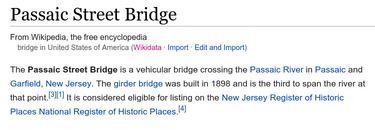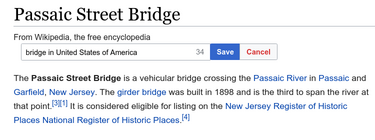| Description | Allows easy changing and importing of short descriptions |
|---|---|
| Author(s) | Galobtter |
| Status | Stable |
| Version | 3.5.3 |
| Updated | October 5, 2023; 15 months ago |
| Skins |
|
| Source | |
| GitHub repository | shortdesc-helper |
Shortdesc helper (SDH) is a gadget for adding, editing, and importing short descriptions.
Enabling
edit- Navigate to the Gadgets tab of your Preferences page.
- In the "Editing" section, Check the box next to "Shortdesc helper: easily add and edit page short descriptions".
- Click the Save button at the bottom of the page.
In the "Testing and development" section, the box next to "Show page description beneath the page title" should be Unchecked to avoid confusion.
This gadget may be used in conjunction with the page assessments or Xtools gadgets.
If you already have this script installed via the previous installation method, uninstall it first by removing the importScript('User:Galobtter/Shortdesc helper.js'); line from your Special:MyPage/common.js or Special:MyPage/skin.js pages.
Usage
editWhen activated, the article's short description will be displayed on the page immediately under the line "From Wikipedia, the free encyclopedia", and edits may be made by clicking the buttons to the right of the short description (see image). An edit summary may be added using the "summary" button.
If there is no local short description but there is a Wikidata description, the gadget will instead show that in pink, with an option to import it to Wikipedia (capitalising the first letter).
By default, adding short descriptions to an article also adds the description to Wikidata if Wikidata has no description. This can be changed in the settings.
Options
editShortdesc helper may be configured using the settings window that can be accessed when editing or adding a short description by clicking the gear-wheel button on the right.

Installation on another wiki
editShortdesc helper will automatically detect if it is loaded on another wiki, and allow viewing and editing of Wikidata descriptions on those wikis.
For individual use
editAdd
mw.loader.getScript( 'https://en.wiki.x.io/w/load.php?modules=ext.gadget.libSettings' ).then( function() {
mw.loader.load( 'https://en.wiki.x.io/w/load.php?modules=ext.gadget.Shortdesc-helper' );
})
to Special:MyPage/common.js on that wiki to use the script on another wiki.
As a gadget
editTo install Shortdesc helper on another wiki, create a file named "MediaWiki:Gadget-Shortdesc-helper.js" with the content (comments there note how to localize):
window.sdh = {};
/* These messages can be changed to localize Shortdesc helper for your wiki.
** If that is not necessary, then this can be removed, and English-language messages will be used. */
window.sdh.messages = {
/** Uncomment the following to change messages used in settings dialog */
/*
"libSettings-settings-title": "Settings",
"libSettings-save-label": "Save settings",
"libSettings-cancel-label": "Cancel",
"libSettings-showDefaults-label": "Show defaults",
"libSettings-showCurrentSettings-label": "Show current settings",
"libSettings-save-success-message": "Settings for $1 successfully saved.",
"libSettings-save-fail-message": "Could not save settings for $1.",
*/
/* Settings messages */
'sdh-settingsDialog-title': 'Settings for Shortdesc helper',
'sdh-header-general': 'General',
'sdh-header-appearance': 'Appearance',
'sdh-AddToRedirect-label': 'Allow additions of short descriptions to redirects',
'sdh-AddToRedirect-help': 'When checked, redirects will have an "add" button to add a short description. (default off)',
'sdh-InputWidth-label': 'Width of editing input in characters (default 40)',
'sdh-FontSize-label': 'Font size, as a percentage (default 100%)',
/* Initial view messages */
'sdh-missing-description': 'Missing <a href="/wiki/Wikipedia:Short description">$1 description</a>',
/* Initial view buttons */
'sdh-add-label': 'Add',
'sdh-add-title': 'Add short description',
'sdh-edit-label': 'Edit',
'sdh-edit-title': 'Edit short description',
/* Editing messages */
'sdh-description-placeholder': 'Short description',
'sdh-summary-placeholder': 'Custom edit summary',
'sdh-save-label': 'Save',
'sdh-save-title': 'Save description',
'sdh-cancel-label': 'Cancel',
'sdh-cancel-title': 'Cancel editing',
'sdh-summary-label': 'Summary',
'sdh-summary-title': 'Show edit summary box',
'sdh-settings-title': 'Settings',
/* Wikidata summary messages */
'sdh-wd-summary': '([[w:en:Wikipedia:Shortdesc helper|Shortdesc helper]])',
'sdh-wd-edit-failed': 'Saving the edit to Wikidata failed.',
'sdh-wd-edit-failed-prefix': '\n\nThe info given by Wikidata is that:\n\n'
};
mw.loader.getScript( 'https://en.wiki.x.io/w/load.php?modules=ext.gadget.libSettings' ).then( function() {
mw.loader.load( 'https://en.wiki.x.io/w/load.php?modules=ext.gadget.Shortdesc-helper' );
})
and create a CSS file named "MediaWiki:Gadget-Shortdesc-helper-pagestyles-vector.css" with the content of MediaWiki:Gadget-Shortdesc-helper-pagestyles-vector.css.
Then, add to MediaWiki:Gadgets-definition:
* Shortdesc-helper-loader[ResourceLoader|dependencies=mediawiki.api,mediawiki.notify,user.options,mediawiki.util|skins=vector,monobook,modern,timeless|peers=Shortdesc-helper-pagestyles-vector]|Shortdesc-helper.js
* Shortdesc-helper-pagestyles-vector[hidden|skins=vector]|Shortdesc-helper-pagestyles-vector.css
See also
edit- Edits made using this gadget
- Short description in Category
{{User wikipedia/Shortdesc helper}}, a userbox indicating an editor uses Shortdesc helper

Amos Wilnai
editAmos Wilnai (Hebrew: עמוס וילנאי) was born in 1939 is an Israeli-American electrical engineer, hi-tech executive, entrepreneur, and philanthropist. He is now retired and lives in Palo Alto, California. Wilnai pioneered chip design in Israel. He taught at the Technion, Israel Institute of Technology (1973), and was part of the founding team and led chip design at both Intel Israel (1974) and National Semiconductor Israel (1978). In 1982 he founded Clarity Ltd. of Herzliya, Israel, and in 1997 founded MMC Networks of Sunnyvale California. Wilnai is currently President of the Amos & Ruth Wilnai Foundation, a non-profit California charitable corporation. Wilnai holds a B.Sc. degree in electrical Engineering from the Technion, Israel Institute of Technology (1964), and an M.S. degree in Electrical Engineering from the Polytechnic Institute of Brooklyn (1966).
Early years (Israel)
editWilnai was born in July 1939 at the Beilinson Hospital in Petach Tikvah, in what was then the British mandate of Palestine. His father, Yisrael Wilnai (Wilner), was a metal turner who at 17 years old immigrated to Israel from Belarus, and his mother, Miriam Wilnai (Trachtman), was a kindergarten teacher, who at 4 years old immigrated to Israel from Ukraine. Both were escaping horrific living conditions and rising antisemitism in post WW I Eastern Europe. Wilnai went to Beit Hinuch A’ (בית חינוך א') Elementary School (1945-1953) and to Ironi D’ High School (עירוני ד' תיכון) (1953-1957) in Tel Aviv. In high school Wilnai was active in the Tel Aviv Flying Club (קלוב התעופה לישראל) and in the pre-military training of the Israeli Air Force (גדנ"ע אויר). In August 1957 he enlisted in the Israeli Defense Force (IDF). He was discharged from active duty in July 1960 as a tank platoon commander with the rank of Lieutenant. Following his mandatory military service Wilnai enrolled at the Technion, Israel Institute of Technology in Haifa, Israel, graduating in 1964 with a B.Sc. degree in Electrical Engineering.
Early Employment (USA)
editIn July 1964 Wilnai traveled to the United States to study for his master’s degree in Electrical Engineering at the Brooklyn Polytechnic Institute (now part of NYU). He completed the degree requirements in 1965, and in December that year presented his thesis research “Stratified Media Optic Cavitiesיי at the 1965 Winter Meeting of the America Physical Society at UCLA. From August 1965 until July 1967 he worked in the electronic division of Corning Glass Works, first in Bradford PA and then in Raleigh NC, designing glass delay line memory systems. In July 1967 Wilnai joined the R&D division of Signetics Corp. of Sunnyvale, California, an early semiconductor company (then a Corning Glass’ subsidiary), where he studied bipolar and MOS processes and designed for Signetics’ a new MOS-based product line. In 1970 he Joined Monolithic Memories Inc. (MMI) of Sunnyvale, California where he designed and introduced a new MOS product line. In December 1972 Wilnai accepted an offer from Uzia Galil, Elbit Computers’ Founder and CEO, to establish a chip design center, Israel’s first, and returned with his family to Israel.
Early days of the Israeli Semiconductor industry (1973-1987)
editOn his Arrival to Elbit Wilnai found out that the promised funding for the chip design center is not forthcoming and settled as a special consultant to Elbit’s President for the procurement of the newly introduced chip components. He also took a position of Adjunct Lecturer at the Electrical Engineering faculty of the Technion, Israel Institute of Technology, where he taught semiconductors and chip design to senior and graduate students. In 1973 Wilnai initiated With Professor Yitzhak Kidron of the Technion, what was arguably the world's first formal training of students in chip design: a two-semester project in which senior year students designed, laid out and characterized an integrated circuit that was built between semesters by Prof. Kidron in his microelectronic lab. This program was instrumental in Intel’s decision to establish its first overseas chip design center in Haifa, Israel. In the years that followed, graduates of this program held leading positions in Israel’s emerging semiconductor industry. In July 1974 Wilnai joined Intel’s Israeli Design Center in Haifa at its inception. He hired and trained the technical staff, designed the Israeli Center first product, a 256x4 bits static random-access memories (2101/2111/2112), and managed the development of its other early products: peripheral devices for Intel’s 8080, 8085 and 8086 microprocessors.
In 1978 he moved to National Semiconductor to establish its newly formed chip design center in Herzliya. National sought to challenge Intel’s dominance in microprocessors and chartered the Center with the development of the NS32000, a 32-bit microprocessor chip. Here Wilnai handled the startup logistics, hired and trained the technical staff, and managed the microprocessor chip development.
In 1982 Wilnai founded and was the CEO of Clarity Ltd. (initially named Softel) of Herzliya, Israel. Clarity aimed to revolutionize chip design with a fully integrated CAD (computer aided design) system. The Company didn’t make it in the marketplace and ceased operations in 1987.
MMC Networks
editIn 1992 Wilnai founded MMC Networks of Sunnyvale California and was its active Chairman and interim CEO. MMC was a fabless semiconductor company specialized in high-end, network-specific microprocessors. The Company started as a bootstrap operation, received first round VC funding ($3.1M) in 1994, went public on NASDAQ in 1997, and was acquired in 2000 by Applied Micro Circuit Corporation (AMCC) of San Diego, California for $4.5 Billion (a deal billed by the press as the second largest in semiconductor history).
Charity
editIn 2006 Wilnai established with his wife Ruth the Amos and Ruth Wilnai Foundation, a non-profit charitable California organization that focuses on advancing underprivileged children and at-risk youth, and on social change.
Personal life
editAmos Married Ruth Wilnai (Arieli) in November 1970 in California. They live in Palo Alto, California and have three children: Sigal, Yael and Nitzan, and seven grandchildren. In his free time Amos enjoyes aerobatic flying, biking, swimming, adventure travel, gardening, woodworking, and nature photography.
List of Publications
edit- “Stratified Media Optic Cavitiesיי, (M.S. thesis), presented at the 1965 Winter Meeting of the America Physical Society, UCLA, December 20-22, 1965.
- Open-Ended RC Line Model Predicts MOSFET IC Response, EDN/EEE, December 15, 1971.
- Logic Driving Gates Double as D-A converter switches, Electronics, August 14, 1972.
- Finding MOSFET Threshold with One Measurement, Electronics, September 11, 1972.
- Eliminating Clock Waveform Imperfections in MOS Dynamic Circuits, Computer Design, September 1973
- Open-Ended RC Line Model Predict MOSFET IC Response, EDN/EEE, December 15, 1971
- Design Consideration for Scanned Photodiode Arrays, Symposium on Microwaves, Antennas and Electron Devices, Tel Aviv, April 2-3, 1974 (with Prof. Yitzhak Kidron)
Press
edit- Moran Bar-Kochva, “Amos Wilnai Owns $520 Mln of Shares Following MMC Networks, AMCC Merger”, Globes/Arena, 2000-08-28
- Mary Sagi-Maydan, “Amos Wilnai shares his secret to success”, Haaretz English Internet Edition, 2000-09-03

